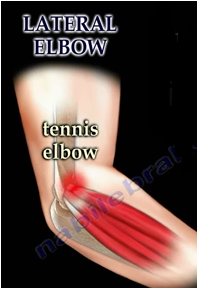Tennis elbow, also known as lateral epicondylitis, is an overuse injury due to inflammation of the tendons attaching the forearm muscles to the lateral (outside) epicondyle (bony prominence on the outside of the elbow). Usually occurring in the extensor carpi radialis brevis muscle, tennis elbow is the most common injury in patients with elbow pain. As the muscles are repetitively used, tissue inflammation or tears occur in the tendons attaching the forearm muscles to the lateral epicondyle.
While some may think tennis elbow is purely the result of recreational activities (tennis, squash, etc.), there are several occupational causes for tennis elbow including plumbing, painting, meat cutting and raking.
Patients with tennis elbow will most often report pain on the outside portion of the elbow, pain with wrist extension, forearm weakness, and/or point tenderness over the lateral epicondyle.
To diagnose tennis elbow, physicians utilize a combination of physical examination and diagnostic imaging. During physical examination, physicians will apply pressure to various regions of the elbow and forearm and also ask patients to move their elbow, wrist and fingers in various ways. Physicians will also look for pain with applied pressure to the lateral epicondyle and pain with passive wrist flexion and resisted wrist extension. X-ray or MRI imaging may be utilized to rule out fracture or arthritis.
Differential Diagnosis:
Radial tunnel syndrome pain is very similar to the symptoms of tennis elbow. However, pain is usually distal to the lateral epicondyle and radiates down to the forearm. If symptoms of tennis elbow are not improving with treatment, physicians should rule out the possibility of radial tunnel syndrome.
Tennis elbow is usually treated with a variety of conservative modalities. First, rest, ice and anti-inflammatory medications can be used to reduce inflammation. Another conservative measure is strengthening and stretching muscles through exercise. Physicians may also suggest braces or straps to reduce stress on the inflamed tissue. If these measures fail, physicians will likely perform corticosteroid injections to reduce pain, swelling and inflammation. While these injections provide temporary relief, they may not provide adequate long-term benefits.
There is also a new injection technique utilizing platelet-rich plasma. The idea behind platelet-rich plasma injections is to extract blood from a healthy part of the body, increase the platelet count through centrifugation, and then re-inject the platelet-rich plasma into an injured area. Here, the body utilizes its ability to heal itself by stimulating growth factors and promoting healing. In about 10 percent of patients, surgery is needed. In surgery, the diseased tissue is removed and is usually successful in about 85% to 90% of patients. However, surgery is the last resort.
While tennis elbow is a relatively common injury, there are certain preventative measures that can be taken, including, warming up properly, utilizing ice, building strength and flexibility through exercise and reviewing your technique to lessen the risk of tennis elbow.
For more videos on Tennis Elbow, check out the links below:
https://www.youtube.com/watch?v=uSHNPJQEs4Q
For more videos, visit my YouTube page at the link below:

